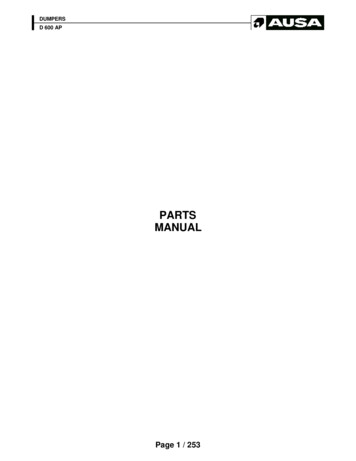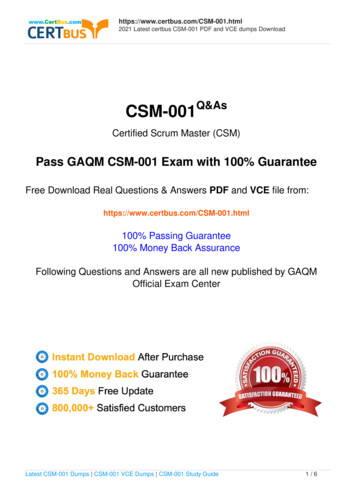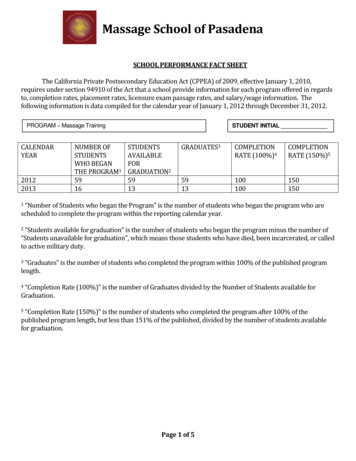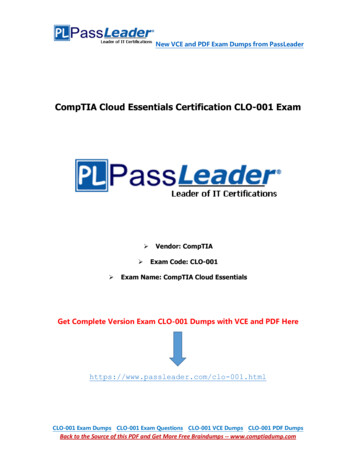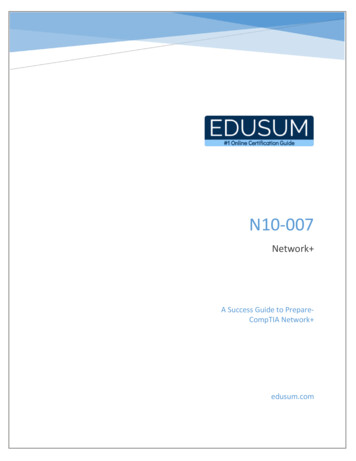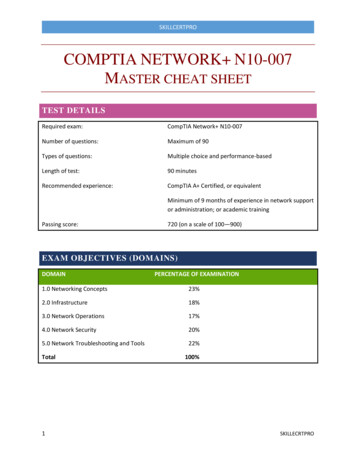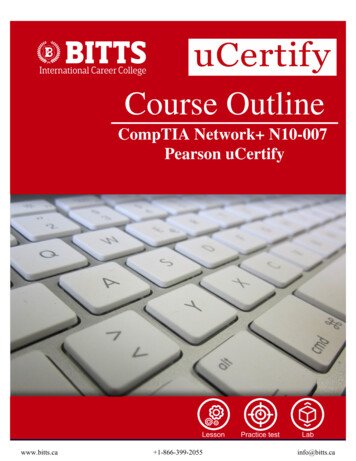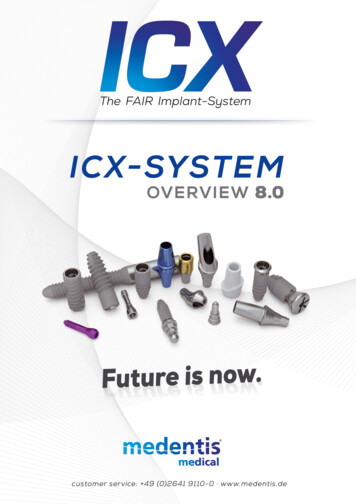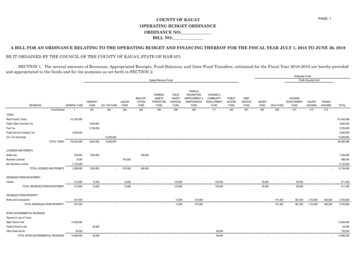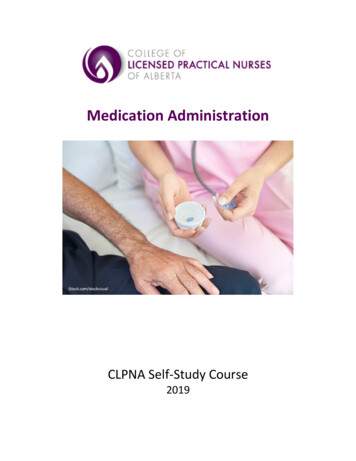
Transcription
ES04 SG TOC.qxd9/19/068:51 PMPage iHOLTEnvironmental ScienceStudy Guide.
ES04 SG TOC.qxd9/19/068:51 PMPage iiTO THE STUDENTThis Study Guide contains Concept Review worksheets, which can be used inseveral ways to guide you through your textbook. The worksheets can be used asa pre-reading guide to each chapter to help you identify the main concepts ofeach chapter before your initial reading. You can also use the worksheets afterreading each chapter to test your understanding of the chapter’s main conceptsand terminology. Finally, you can use the worksheets to prepare for your environmental science exams. Regardless of how you and your teacher use the HoltEnvironmental Science Study Guide, it will help you determine which topicsyou have learned well and which topics you need to study further.Copyright by Holt, Rinehart and WinstonAll rights reserved. No part of this publication may be reproduced or transmitted inany form or by any means, electronic or mechanical, including photocopy, recording,or any information storage and retrieval system, without permission in writing fromthe publisher.Teachers using HOLT ENVIRONMENTAL SCIENCE may photocopy complete pages insufficient quantities for classroom use only and not for resale.HOLT and the “Owl Design” are trademarks licensed to Holt, Rinehart and Winston,registered in the United States of America and/or other jurisdictions.Printed in the United States of AmericaIf you have received these materials as examination copies free of charge, Holt, Rinehartand Winston retains title to the materials and they may not be resold. Resale ofexamination copies is strictly prohibited.Possession of this publication in print format does not entitle users to convert thispublication, or any portion of it, into electronic format.ISBN-13: 978-0-03-093112-3ISBN-10: 0-03-093112-61 2 3 4 5 6 7 862 09 08 07 06
ES04 SG TOC.qxd 12/13/02 7:39 PM Page iiiContentsConcept Review WorksheetsScience and the Environment . . . . . . . . . . . . . . . . . . . . . . . . . . . . . 1Tools of Environmental Science . . . . . . . . . . . . . . . . . . . . . . . . . . . 3The Dynamic Earth . . . . . . . . . . . . . . . . . . . . . . . . . . . . . . . . . . . . 5The Organization of Life . . . . . . . . . . . . . . . . . . . . . . . . . . . . . . . . 7How Ecosystems Work . . . . . . . . . . . . . . . . . . . . . . . . . . . . . . . . . . 9Biomes . . . . . . . . . . . . . . . . . . . . . . . . . . . . . . . . . . . . . . . . . . . . . 11Aquatic Ecosystems . . . . . . . . . . . . . . . . . . . . . . . . . . . . . . . . . . . . 13Understanding Populations . . . . . . . . . . . . . . . . . . . . . . . . . . . . . . 15The Human Population . . . . . . . . . . . . . . . . . . . . . . . . . . . . . . . . . 17Biodiversity . . . . . . . . . . . . . . . . . . . . . . . . . . . . . . . . . . . . . . . . . . 19Water . . . . . . . . . . . . . . . . . . . . . . . . . . . . . . . . . . . . . . . . . . . . . . 21Air . . . . . . . . . . . . . . . . . . . . . . . . . . . . . . . . . . . . . . . . . . . . . . . . 23Atmosphere and Climate Change . . . . . . . . . . . . . . . . . . . . . . . . . . 25Land . . . . . . . . . . . . . . . . . . . . . . . . . . . . . . . . . . . . . . . . . . . . . . . 27Food and Agriculture . . . . . . . . . . . . . . . . . . . . . . . . . . . . . . . . . . . 29Mining and Mineral Resources . . . . . . . . . . . . . . . . . . . . . . . . . . . . 31Nonrenewable Energy . . . . . . . . . . . . . . . . . . . . . . . . . . . . . . . . . . 33Renewable Energy . . . . . . . . . . . . . . . . . . . . . . . . . . . . . . . . . . . . . 35Waste . . . . . . . . . . . . . . . . . . . . . . . . . . . . . . . . . . . . . . . . . . . . . . 37The Environment and Human Health . . . . . . . . . . . . . . . . . . . . . . . 39Economics, Policy, and the Future . . . . . . . . . . . . . . . . . . . . . . . . . 41Copyright by Holt, Rinehart and Winston. All rights reserved.Holt Environmental ScienceiiiStudy Guide
ES04 SG TOC.qxd 12/13/02 7:39 PM Page iv
ES04 Ch01 001-007.qxd12/13/026:33 PMPage 1NameClassDateSkills WorksheetConcept ReviewMATCHINGIn the space provided, write the letter of the description that best matches theterm or phrase.1. practice of growing, breeding, and caring forplants and animals used for a variety ofpurposes2. study of how living things interact with eachother and with their nonliving environments3. conflict between short-term interests ofindividuals and long-term welfare of society4. declining number and variety of the speciesin an area5. study of how humans interact with theenvironment6. law describing the relationship between anitem’s availability and its value.a. loss of biodiversityb. supply and demandc. “The Tragedy of theCommons”d. agriculturee. developed nationf. environmentalscienceg. ecologyh. developing nationi. renewable resourcej. sustainability7. characterized by low population growth rate,high life expectancy, and diverse industrialeconomies8. characterized by high population growth rate,low energy use, and very low personal wealth9. state in which a human population can survive indefinitely10. natural material that can be replaced relativelyquickly through natural processesMULTIPLE CHOICEIn the space provided, write the letter of the term orphrase that best completes each statement or best answers each question.11. Which of the following sciences contribute to the field of environmentalscience?a. physics and chemistryc. social sciencesb. biology and earth scienced. all of the aboveCopyright by Holt, Rinehart and Winston. All rights reserved.Holt Environmental Science1Science and the Environment
ES04 Ch01 001-007.qxd12/13/026:33 PMPage 2NameClassDateConcept Review continued12. All of the following make up the three major categories of environmentalproblems excepta. loss of biodiversity.c. resource depletion.b. overpopulation.d. pollution., human13. During the period of human history known as thepopulations grew rapidly because of advances in farming methods.a. Industrial Revolutionc. “Tragedy of the Commons”b. agricultural revolutiond. hunter-gatherer period14. Which major changes in human society and the environment occurredduring the Industrial Revolution?a. People lived in small tribes; many mammals went extinct.b. Domesticated plants were altered; forest was replaced with farmland.c. Fossil fuel consumption, technological efficiency, and environmentalpollution increased.d. Common grazing areas were replaced with closed fields.15. What did hunter-gatherers do to alter the environment?a. introduce plants to newc. burn prairie to maintainregionsgrasslandb. overhunt large mammals d. all of the above16. Developed nations make up aboutpopulation and consume abouta. 20, 75c. 75, 20b. 50, 75d. 75, 50percent of the world’spercent of its resources.17. Hardin’s “Tragedy of the Commons” essay addressed the conflictsassociated with which environmental challenge?a. preventing pollutionc. curbing overpopulationb. preserving biodiversityd. protecting shared resources18. The ecological footprint for a person in a particular country takes intoaccount what requirements of supporting that individual?a. land used for cropsc. forest area that absorbs pollutionb. land taken up by housing d. all of the above19. Attempts to create a sustainable society strive to achieve what?a. greater resource consumption c. negative population growthb. stable resource consumption d. restrictions on technology20. A cost-benefit analysis balances the cost of an action againsta. those who benefit from the action.b. those who perform the analysis.c. what consumers and taxpayers are willing to pay.d. the benefits one expects to receive.Copyright by Holt, Rinehart and Winston. All rights reserved.Holt Environmental Science2Science and the Environment
ES04 CH02 001-006.qxd12/13/025:06 PMPage 3NameClassDateSkills WorksheetConcept ReviewMATCHINGIn the space provided, write the letter of the description that best matches theterm or phrase.1. control group2. predictiona. a logical statement about what will happenin an experiment3. physical modelb. a verbal or graphical explanation for howa system works or how it is organized4. riskc. in an experiment, that which does notreceive the experimental treatment5. conceptual modeld. a three-dimensional model you can touch6. valuee. principles or standards considered to beimportant7. experimentf. the probability of an unwanted outcome8. statisticsg. information gathered during an experiment9. datah. procedure designed to test a hypothesisi. collection and classification of dataMULTIPLE CHOICEChoose the best response. Write the letter of that choice in the space provided.10. When it is not possible to conduct an experiment, scientists test theirpredictions bya. examining correlations.c. testing for one variable.b. using a control.d. remaining skeptical.11. An essential feature of every good experiment is that it shoulda. use a control.c. graph data.b. test a single variable.d. Both (a) and (b)12. The experimental method includes which of the following steps?a. remaining skeptical, organizing data, and analyzing datab. drawing conclusions, being open to new ideas, and communicatingresultsc. observing, hypothesizing, predicting, experimenting, and communicating resultsd. being curious, imagining, being able to see patterns, observing, andpredicting13. What is not a description of a good hypothesis?a. It makes logical sense.b. It is a testable explanation of an observation.c. It follows from what you already know about a situation.d. It is a guess based on previous experiments.Copyright by Holt, Rinehart and Winston. All rights reserved.Holt Environmental Science3Tools of Environmental Science
ES04 CH02 001-006.qxd12/13/025:06 PMPage 4NameClassDateConcept Review continued14. One of the key habits of mind of scientists is, whichallows scientists to expand the boundaries of what we know.a. intellectual honestyc. replicationb. imaginationd. correlation15. A road map is an example of aa. graphical model.b. mathematical model.c. conceptual model.d. physical model.16. Statistics are not used by scientists toa. compare data.c. gather data.b. analyze data.d. All of the above17. In a scientific investigation, the size of the sample population should belarge enough toa. reflect the probability of an unwanted outcome.b. give an accurate estimate of the whole population.c. closely resemble the system they represent.d. All of the above18. If you consider what will add to our understanding of the naturalworld in making an environmental decision, you are examining a(n)value.a. ethical/moralc. environmentalb. aestheticd. scientific19. What is the first step in an environmental decision-making model?a. Explore the consequences of each option.b. Consider which values apply to the issue.c. Make a decision.d. Gather information.20. When you examine a scientific value in making an environmental decision, youa. consider what is right or wrong.b. consider what will maintain human health.c. use your understanding of the natural world.d. think about what will promote learning.21. Which of the following is a possible short-term consequence of creating a nature preserve?a. decrease in habitat destructionb. an increase in property values near the preservec. a restriction of recreational activities on private land within the preserve by state officialsd. all of the aboveCopyright by Holt, Rinehart and Winston. All rights reserved.Holt Environmental Science4Tools of Environmental Science
ES04 CH03 001 006.qxd12/13/025:11 PMPage 5NameClassDateSkills WorksheetConcept ReviewMATCHINGIn the space provided, write the letter of the term or phrase that best matches thedescription.1. boundary between warm and cold water in anocean or a lake2. the pieces that compose the lithosphere3. a mountain built from magma4. transfer of energy through spacea. mantleb. ozonec. faultd. salinitye. tributaries5. water movements in the ocean that are drivenby the windf. tectonic plates6. layer of Earth between the crust and the coreg. thermocline7. a molecule made up of three oxygen atomsh. volcano8. smaller streams or rivers that flow into largeronesi. surface currentsj. radiation9. the total quantity of dissolved salts in the ocean10. break in Earth’s crustMULTIPLE CHOICEIn the space provided, write the letter of the term or phrase that best completeseach statement or best answers each question.11. The part of Earth that contains the air we breathe is called thea. hydrosphere.c. geosphere.b. atmosphere.d. envirosphere.12. The thin outermost layer of the solid Earth is called thea. asthenosphere.c. outer core.b. mantle.d. crust.13. An earthquake of magnitude 5.0 releases how much more energy thanan earthquake of magnitude 4.0?a. twice the energyb. three times the energyc. one hundred times the energyd. none of the aboveCopyright by Holt, Rinehart and Winston. All rights reserved.Holt Environmental Science5The Dynamic Earth
ES04 CH03 001 006.qxd12/13/025:11 PMPage 6NameClassDateConcept Review continued14. Volcanoes occur at tectonicplate boundaries that area. colliding.b. slipping past one another.c. separating from oneanother.d. Both (a) and (c)20. The warmest temperaturezone of the ocean is thea. thermocline.b. deep zone.c. open ocean.d. surface zone.21. Stream-like movements ofcold, dense water near theocean floor are calleda. surface currents.b. deep currents.c. bottom currents.d. mixing currents.15. The removal and transportof surface material by windand water is calleda. seismicity.b. erosion.c. tectonics.d. vulcanism.22. One of the most importantroles of the ocean is toa. add oxygen to the atmosphere.b. trap heat near Earth.c. regulate temperatures inEarth’s atmosphere.d. absorb ultraviolet radiation.16. The stratosphere is theatmospheric layer above thea. troposphere.b. ionosphere.c. mesosphere.d. thermosphere.17. Which of the following gasesis an important greenhousegas?a. hydrogenb. nitrogenc. carbon dioxided. oxygen23. The narrow layer of Earthwhere life-supporting conditions exist is called thea. crust.b. surface zone.c. troposphere.d. biosphere.18. The most abundant gas inEarth’s atmosphere isa. oxygen.b. carbon dioxide.c. nitrogen.d. hydrogen.24. With respect to matter,Earth is mostlya. an open system.b. a closed system.c. an ecosystem.d. a biosphere.19. The transfer of heat by aircurrents (or currents in aliquid) is calleda. radiation.b. conduction.c. convection.d. condensation.25. The most important dissolvedelements in ocean water area. calcium and magnesium.b. calcium and potassium.c. calcium and sodium.d. sodium and chlorine.Copyright by Holt, Rinehart and Winston. All rights reserved.Holt Environmental Science6The Dynamic Earth
ES04 CH04 001-006.qxd12/13/025:09 PMPage 7NameClassDateSkills WorksheetConcept ReviewMATCHINGIn the space provided, write the letter of the term or phrase that best matches thedescription.a. ecosystem1. an individual living thing2. a group of various species that live in thesame place and interact with each other3. living or once living part of an ecosystem4. unequal survival and reproduction thatresults from the presence or absence ofparticular traitsb. populationc. natural selectiond. organisme. resistancef. abiotic factorg. evolutionh. species5. all the organisms living in an area andtheir physical environmenti. communityj. biotic factor6. change in the genetic characteristicsof a population from one generation tothe next7. all the members of the same species thatlive in the same place at the same time8. nonliving part of an ecosystem9. ability of one or more organisms totolerate a particular chemical designedto kill it10. group of organisms that are closelyrelated and that can mate to producefertile offspringMULTIPLE CHOICEIn the space provided, write the letter of the term or phrase that best completeseach statement or best answers each question.11. What kind of habitat does a red backed salamander need to survive?a. damp forest floorb. sunny top of a treec. dry forest floord. sunny desert rockCopyright by Holt, Rinehart and Winston. All rights reserved.Holt Environmental Science7The Organization of Life
ES04 CH04 001-006.qxd12/13/025:09 PMPage 8NameClassDateConcept Review continued12. Which of the following kingdoms include organisms thatcan make their own food?a. protists and plantsb. plants and animalsc. fungi and plantsd. fungi and protists17. One way that bacteria andfungi are important to theenvironment is that theya. produce oxygen.b. use the sun’s energy tomake their own food.c. are a major food sourcein many ecosystems.d. break down deadorganisms.13. The Chihuahua is a dog thatexists because ofa. natural selection.b. artificial selection.c. resistance.d. abiotic factors.18. Phytoplankton are importantprotists because they are theinitial source ofa. food in most landecosystems.b. food in most ocean andfreshwater ecosystems.c. oxygen in the atmosphere.d. Both (a) and (b)14. Humans have promoted theevolution of insects that areresistant to insecticides bya. trying to control pestswith chemicals.b. using insecticides that areoutdated.c. using the wronginsecticide.d. breeding more usefulinsects.19. Many angiosperms dependona. other animals in theoceans.b. gymnosperms forreproducing.c. plants for food.d. animals to carry pollenand disperse seeds.15. Which of the following is nottrue of an adaptation?a. It is an advantage to anorganism in certainenvironments.b. It increases an organism’schance of reproducing.c. It increases an organism’schance of survival.d. It decreases an organism’s chance of evolving.20. Which of the following characteristics is shared by bacteria, fungi, and plants?a. They usually have cellwalls.b. They have cell nuclei.c. They are single celled.d. They have the ability tomake their own food.16. Which of the following isnot one of the kingdoms ofliving things?a. archaebacteriab. protobacteriac. eubacteriad. protistsCopyright by Holt, Rinehart and Winston. All rights reserved.Holt Environmental Science8The Organization of Life
ES04 CH05 001-007.qxd12/13/025:12 PMPage 9NameClassDateSkills WorksheetConcept ReviewMATCHINGIn the space provided, write the letter of the term or phrase that best matches thedescription.a. photosynthesis1. two types of consumers2. a diagram showing the many feedingrelationships that are in an ecosystem3. the process in which energy from thesun is used by plants to make sugarmolecules4. illustrates the loss of energy from onetrophic level to the next5. organisms that get their energy byeating other organisms6. stored carbon from the remains ofplants and animals that died millionsof years agob. rabbit and coyotec. fossil fuelsd. producerse. food webf. consumersg. atmospheric CO2h. energy pyramidi. algal bloomj. atmospheric N2k. food chainl. old-field successionm. nitrogen-fixing bacteria7. organisms that make their own food8. change that occurs on an abandonedfarm9. a part of the carbon cycle10. results from excessive use of fertilizers11. organisms that transform atmosphericnitrogen into usable nitrogencompounds12. part of the nitrogen cycle13. transfer of energy from one organismto anotherCopyright by Holt, Rinehart and Winston. All rights reserved.Holt Environmental Science9How Ecosystems Work
ES04 CH05 001-007.qxd12/13/025:12 PMPage 10NameClassDateConcept Review continuedMULTIPLE CHOICEIn the space provided, write the letter of the term or phrase that best completeseach statement or best answers each question.14. What are the first organismsto colonize any newly available area called?a. climax speciesb. fernsc. pioneer speciesd. mosses19. Which of the following is anherbivore?a. cowb. lionc. beard. grass20. Which of the following is aproducer?a. oak treeb. raccoonc. cockroachd. human15. Which of the following is aproducer that breaks downrock?a. pioneer producerb. fungal speciesc. algaed. lichen21. Which of the following is aprocess in the cell wherebyglucose and oxygen producecarbon dioxide, water, andenergy?a. photosynthesisb. cellular respirationc. synthesisd. decomposition16. Humans are affecting the balance of the carbon cycle bya. burning fossil fuels.b. using carbonates at analarming rate.c. using fertilizers.d. replanting the rainforests.22. Which of the followingorganisms would be foundat the top of an energypyramid?a. algab. krillc. leopard seald. killer whale17. What is a pattern of changethat occurs on a surfacewhere an ecosystem haspreviously existed?a. primary successionb. secondary successionc. tertiary successiond. climax community23. Humans usually get thephosphorus that theirbodies need froma. eating plants and animalsthat contain phosphorus.b. mining.c. food additives.d. drinking water.18. What do deep-ocean bacteria use to make their food?a. the sunb. hydrogen sulfidec. carbon dioxided. sugar moleculesCopyright by Holt, Rinehart and Winston. All rights reserved.Holt Environmental Science10How Ecosystems Work
ES04 CH06 001-006.qxd12/13/025:14 PMPage 11NameClassDateSkills WorksheetConcept ReviewMATCHINGMatch each example in the left column with the appropriate term from the rightcolumn.1. regions that have distinctive climatesand organismsa. latitudeb. understoryc. savanna2. the broad band of coniferous forestlocated just below the Arctic Circled. estivation3. plant with thick, fleshy stemse. succulent4. sleeping through the dry season5. characterized by dry conditions, shortsummers, and thin soil6. tropical and subtropical grasslands,wet summers, dry wintersf. altitudeg. biomesh. tundrai. permafrostj. taiga7. includes trees and shrubs adapted toshade8. the distance north or south of theequator, measured in degrees9. lies beneath the topsoil of the tundra10. height of an object above sea levelMULTIPLE CHOICEIn the space provided, write the letter of the word or statement that best answersthe question or completes the sentence.11. Thin soil, high humidity, and high rainfall represent aa. tropical rain forest.b. temperate rain forest.c. desert.d. grassland.12. Birds that migrate during winter, coniferous plants, and cold temperatures representa. the South Pole.b. taiga.c. a temperate rain forest.d. a chaparral.Copyright by Holt, Rinehart and Winston. All rights reserved.Holt Environmental Science11Biomes
ES04 CH06 001-006.qxd12/13/025:14 PMPage 12NameClassDateConcept Review continued13. The top layer in a tropical rain forest is thea. canopy.b. understory.c. emergent layer.d. tree line.14. Extreme temperatures, abundant precipitation, rich, deep soils, and agrowing season of four to six months represent aa. tropical rain forest.b. taiga.c. temperate deciduous forest.d. savanna.15. The biome with the highest species diversity is thea. taiga.b. tundra.c. tropical rain forest.d. savanna.16. Hot summers and cold winters, low to moderate rainfall, few trees,and rich, fertile soil represent aa. tundra.b. temperate grassland.c. temperate deciduous forest.d. desert.17. As you move from the equator toward the North Pole, you would belikely to seea. rain forests, then deserts, then taiga.b. tundra, then deserts, then grasslands.c. grasslands, then tundra, then rain forests.d. temperate deciduous forests, then taiga, then rain forests.18. Factors that influence where plants grow includea. longitude.b. climate.c. biome maps.d. Both (a) and (b)Copyright by Holt, Rinehart and Winston. All rights reserved.Holt Environmental Science12Biomes
ES04 CH07 01-06 CO.qxd12/13/025:15 PMPage 13NameClassDateSkills WorksheetConcept ReviewMATCHINGIn the space provided, write the letter of the term or phrase that best matchesthe description.1. wetland dominated by nonwoody plants2. precipitation that can carry pollutants intoaquatic ecosystems3. amount of dissolved salts in watera. swampb. benthic zonec. damsd. decomposerse. littoral zone4. wetland dominated by woody plantsf. eutrophication5. area where fresh water mixes with salt waterg. overfishing6. limestone ridges built by tiny animalsh. salinityi. runoff7. located near the bottom of a pond or lakej. marsh8. organisms that break down dead organismsk. coral reefs9. increase in nutrients in an aquatic ecosysteml. estuary10. aquatic zone found near the shore11. threat against a river ecosystem12. threat against marine organismsMULTIPLE CHOICEIn the space provided, write the letter of the term or phrase that best completeseach statement or best answers each question.13. Estuaries are productive ecosystems because they constantly receivenutrients froma. rivers and oceans.b. coral reefs.c. lakes and ponds.d. photosynthesis.14. Which of the following is a factor that influences where an organismlives in an aquatic ecosystem?a. sunlightb. nutrient availabilityc. temperatured. all of the aboveCopyright by Holt, Rinehart and Winston. All rights reserved.Holt Environmental Science13Aquatic Ecosystems
ES04 CH07 01-06 CO.qxd12/13/025:15 PMPage 14NameClassDateConcept Review continued15. In which of the following aquatic ecosystems are both littoral and benthic zones most likely found?a. open oceanb. coral reefc. laked. none of the above16. What is the source of most ocean pollution?a. activities on landb. climate changesc. aquatic animalsd. none of the above17. Estuariesa. are always saltwater ecosystems.b. are always freshwater ecosystems.c. are ecosystems where both fresh water and salt water are present.d. prevent the development of salt marshes.18. All of the following are examples of saltwater ecosystems excepta. mangrove swamps.b. coral reefs.c. salt marshes.d. the Florida Everglades.19. One way in which wetlands control flooding is bya. filtering out water pollutants.b. absorbing water from rivers.c. providing habitats for migratory wildlife.d. reducing the amount of carbon dioxide released into the air.20. Which of the following is not a threat to coral reefs?a. silt runoffb. excessive nutrientsc. growth of algaed. zooplanktonCopyright by Holt, Rinehart and Winston. All rights reserved.Holt Environmental Science14Aquatic Ecosystems
ES04 CH08 001-006.qxd12/13/025:17 PMPage 15NameClassDateSkills WorksheetConcept ReviewMATCHINGIn the space provided, write the letter of the description that best matches theterm or phrase.1. interaction between two species inwhich both are harmeda. densityb. growth ratec. reproductive potential2. the functional role of a species within anecosystemd. carrying capacity3. one of the three main properties of apopulatione. density independentregulation4. development of adaptations as a resultof symbiotic relationshipsf. nicheg. habitath. competition5. maximum population that an ecosystemcan support indefinitelyi. parasitismj. coevolution6. close interaction between two species inwhich one organism benefits while theother organism is harmed7. the ratio of births to deaths in a population8. maximum number of offspring that eachmember of a population can produce9. a reduction in population size caused bya natural disaster10. the location where an organism livesMULTIPLE CHOICEIn the space provided, write the letter of the term or phrase that best completeseach statement or best answers each question.11. A territory isa. a place where one animal lives.b. a place where people eat.c. an area defended by one or more individuals.d. a place for sleeping.12. Which of the following is an example of a parasite?a. worm in your intestinec. bee stinger in your armb. a lion hunting zebrasd. honeybee on a flowerCopyright by Holt, Rinehart and Winston. All rights reserved.Holt Environmental Science15Understanding Populations
ES04 CH08 001-006.qxd12/13/025:17 PMPage 16NameClassDateConcept Review continued13. Bacteria in your intestines are an example of mutualism if theya. make you sick.b. have no effect on you.c. are destroyed by digestive juices.d. help you break down food.14. Predators kill their prey.a. alwaysc. neverb. usuallyd. try not to15. What property of a population may be described as even, clumped, orrandom?a. dispersionc. sizeb. densityd. growth rate16. What can occur if a population has plenty of food and space, and hasno competition or predators?a. reduction of carrying capacity c. zero population growthb. exponential growthd. coevolution17. A grizzly bear can be all of the following except aa. parasite.c. mutualist.b. competitor.d. predator.18. The “co-” in coevolution meansa. apart.b. together.c. two.d. predator-prey.19. Which of the following has the greatest effect on reproductivepotential?a. producing more offspring at a timeb. reproducing more oftenc. having a longer life spand. reproducing earlier in life20. Members of a species may compete with one another fora. running faster.c. giving birth.b. social dominance.d. mutualism.21. A robin that does not affect the tree in which it nests is an example ofa. parasitism.c. mutualism.b. commensalism.d. predation.22. Two species can be indirect competitors for food if theya. use the same food source at different times.b. have different food sources.c. fight over food.d. eat together peacefully.Copyright by Holt, Rinehart and Winston. All rights reserved.Holt Environmental Science16Understanding Populations
ES04 CH09 001-06.qxd12/13/025:19 PMPage 17NameClassDateSkills WorksheetConcept ReviewMATCHINGIn the space provided, write the letter of the term or phrase that best matches thedescription.1. highest birth ratesa. demography2. the distribution of ages in a specificpopulation at a certain time3. percentage of members of a group thatare likely to survive to a given age4. movement of individuals out of apopulationb. age structurec. emigrationd. infrastructuree. arable landf. least-developed countriesg. survivorshiph. demographic transition5. the study of populationsi. urbanization6. movement of people into cities fromrural areasj. total fertility rate7. the basic facilities and services that support a community8. land that can be used to grow crops9. a model that describes how changes in a population may occur10. avera
b. imagination d. correlation _15. A road map is an example of a a. graphical model. c. conceptual model. b. mathematical model. d. physical model. _16. Statistics are not used by scientists to a. compare data. c. gather data. b. analyze data. d. All of the above _17. In a scient
